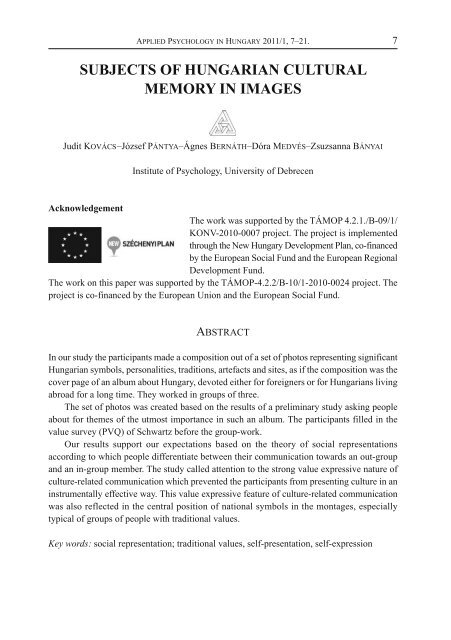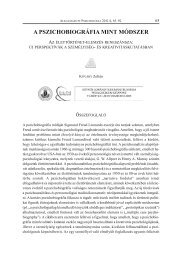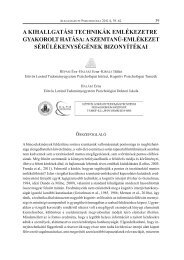APPLIED PSYCHOLOGY IN HUNGARY
APPLIED PSYCHOLOGY IN HUNGARY
APPLIED PSYCHOLOGY IN HUNGARY
Create successful ePaper yourself
Turn your PDF publications into a flip-book with our unique Google optimized e-Paper software.
<strong>APPLIED</strong> <strong>PSYCHOLOGY</strong> <strong>IN</strong> <strong>HUNGARY</strong> 2011/1, 7–21. 7SUBJECTS OF HUNGARIAN CULTURALMEMORY <strong>IN</strong> IMAGESJudit KOVÁCS–József PÁNTYA–Ágnes BERNÁTH–Dóra MEDVÉS–Zsuzsanna BÁNYAIInstitute of Psychology, University of DebrecenAcknowledgementThe work was supported by the TÁMOP 4.2.1./B-09/1/KONV-2010-0007 project. The project is implementedthrough the New Hungary Development Plan, co-financedby the European Social Fund and the European RegionalDevelopment Fund.The work on this paper was supported by the TÁMOP-4.2.2/B-10/1-2010-0024 project. Theproject is co-financed by the European Union and the European Social Fund.ABSTRACTIn our study the participants made a composition out of a set of photos representing significantHungarian symbols, personalities, traditions, artefacts and sites, as if the composition was thecover page of an album about Hungary, devoted either for foreigners or for Hungarians livingabroad for a long time. They worked in groups of three.The set of photos was created based on the results of a preliminary study asking peopleabout for themes of the utmost importance in such an album. The participants filled in thevalue survey (PVQ) of Schwartz before the group-work.Our results support our expectations based on the theory of social representationsaccording to which people differentiate between their communication towards an out-groupand an in-group member. The study called attention to the strong value expressive nature ofculture-related communication which prevented the participants from presenting culture in aninstrumentally effective way. This value expressive feature of culture-related communicationwas also reflected in the central position of national symbols in the montages, especiallytypical of groups of people with traditional values.Key words: social representation; traditional values, self-presentation, self-expression








